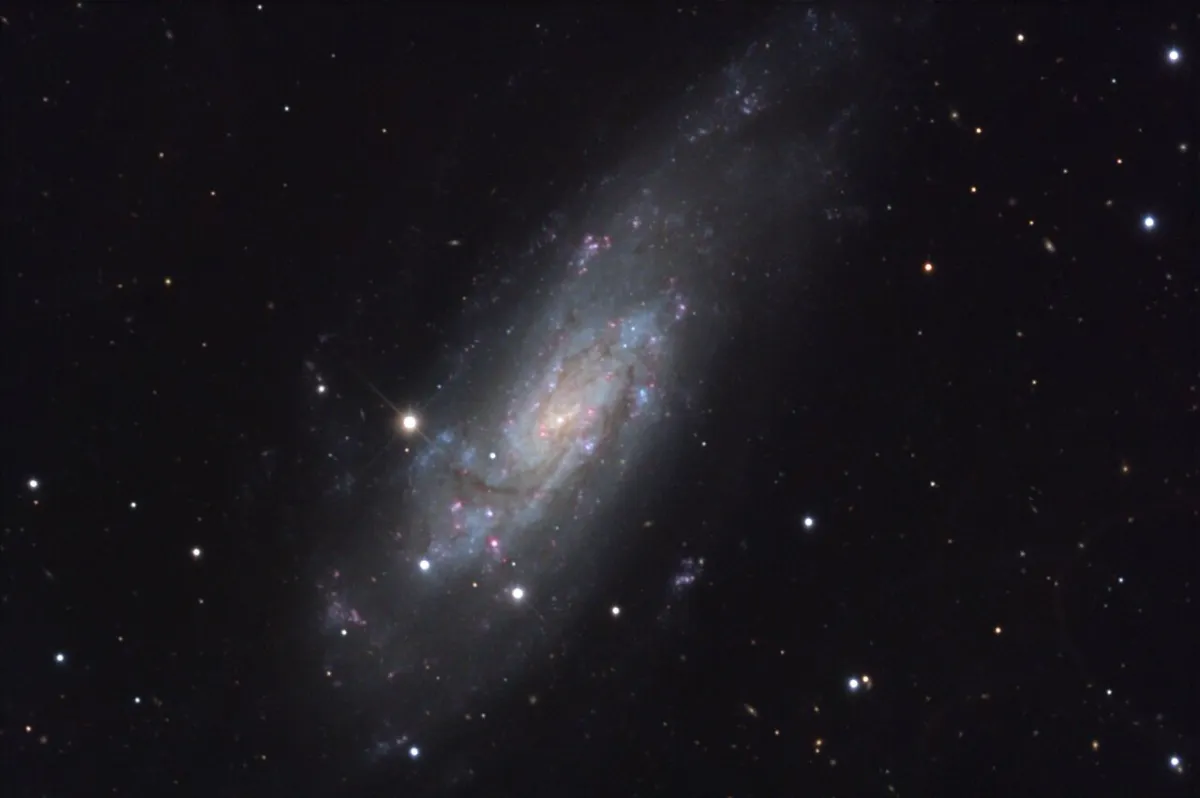Galaxy NGC 4559

History
On 11 April William Herschel discovered a bright nebula and cataloged it as I 92. He logged: «Very bright, very Large, much extended, north preceding, south following, 10 or 12' long, 4 stars in it.» [463] John Herschel listed it as number 1352 in his «Slough Catalogue» from 1833. He made three observations and described it as «very large, gradually brighter in the middle, but not to a nucleus, much extended, has 3 stars south following. By a diagram, the southern end is broader than the northern, giving it a clubbed appearance.» [466] Dreyer added this nebula as NGC 4559 to his «New General Catalogue» of 1888. [313]
On 23 March 1903 German astronomer Max Wolf examined photo plates with the 16-inch Bruce reflector at Koenigstuhl Observatory, Heidelberg and found numerous I-II regions and/or star clouds within NGC 4559 (IC 3550, 3551, 3552, 3555, 3563, 3564) plus two small neighbouring galaxies (IC 3592 and 3593). [277]
Some also use the later added, useless designations: NGC 4559A = IC 3592, NGC 4559B = IC 3593 and NGC 4559C = IC 3550.
Physical Properties
NGC 4559 is a HII Galaxy of morphological type SABcd. It shows bright star-forming regions and dust lanes in its extensive arms. In 1941 a type II supernova occured in this galaxy (SN 1941a). From brightness measurements of the supernova the distance is estimated to be between 20-30 million light years away. Measurements based on redshift result in a distance of 35 million light years. [133]
IC 3550 is a strong source of X-ray radiation (NGC 4559 X7). It is hypothesized to be a scenario of super-Eddington accretion with a light stellar-mass black hole or a neutron star. [135]
The two small galaxies IC 3592 and IC 3593 show a circa ten times higher redshift (IC 3592: z ≈ 0.0249, IC 3593: z ≈ 0.0257) than NGC 4559 (z ≈ 0.00272). Hence they are much farther away and not associated with NGC 4559. [145]
| Name | RA | Dec | Type | bMag | vMag | B-V | SB | Dim | PA | z | D(z) | MD | Dreyer Description | Identification, Remarks |
|---|---|---|---|---|---|---|---|---|---|---|---|---|---|---|
| NGC 4559 | 12 35 57.8 | +27 57 35 | Gx (SBc) | 10.5 | 10.0 | 0.5 | 14.1 | 10.7 × 4.4 | 150 | 0.002692 | 11.37 | 8.520 | vB, vL, mE 150°, gbM, 3 st f | WH I 92; h 1352; GC 3101; UGC 7766; MCG 5-30-30; CGCG 159-24; IRAS 12334+2814 |
| NGC 4559 A | 12 36 53.2 | +27 51 45 | dup | 15.2 | 14.3 | 0.9 | 13.4 | 1 × 0.5 | 126 | 0.025054 | 105.8 | vB, vL, mE 150°, gbM, 3 st f | WH I 92; h 1352; GC 3101; IC 3592; UGC 7789; MCG 5-30-38; MK 775; CGCG 159-31 | |
| NGC 4559 B | 12 36 53.8 | +27 44 55 | dup | 15.4 | 14.6 | 0.8 | 12.4 | 0.5 × 0.3 | 5 | 0.025878 | 109.3 | vB, vL, mE 150°, gbM, 3 st f | WH I 92; h 1352; GC 3101; IC 3593; MCG 5-30-39; MK 776; CGCG 159-30 | |
| NGC 4559 C | 12 35 51.8 | +27 55 57 | dup | 8.520 | vB, vL, mE 150°, gbM, 3 st f | WH I 92; h 1352; GC 3101; IC 3550; HII in N 4559 | ||||||||
| IC 3550 | 12 35 51.8 | +27 55 57 | GxyP | 14.5 | 0.3 | 8.520 | Nuclei inv. in I 92 | NGC 4559C; HII in N 4559 | ||||||
| IC 3551 | 12 35 53.8 | +27 57 50 | GxyP | 14.5 | 0.2 | 8.520 | Nuclei inv. in I 92 | part of N 4559 | ||||||
| IC 3552 | 12 35 54.0 | +27 59 36 | GxyP | 15.5 | 0.1 | 8.520 | Nuclei inv. in I 92 | part of N 4559 | ||||||
| IC 3555 | 12 35 56.0 | +27 59 24 | GxyP | 15.0 | 0.5 | 8.520 | N inv. in I 92 (1s.5 p, 2'.0 n) | part of N 4559 | ||||||
| IC 3563 | 12 36 07.1 | +27 55 36 | GxyP | 15.2 | 0.5 | 8.520 | Nuclei inv. in I 92 | part of N 4559 | ||||||
| IC 3564 | 12 36 08.0 | +27 55 40 | GxyP | 8.520 | Nuclei inv. in I 92 | *Cloud in N 4559 | ||||||||
| IC 3592 | 12 36 53.2 | +27 51 45 | Gx (Sa) | 15.2 | 14.3 | 0.9 | 13.4 | 1 × 0.5 | 126 | 0.025054 | 105.8 | pF, S, lE 140° | NGC 4559A; UGC 7789; MCG 5-30-38; MK 775; CGCG 159-31 | |
| IC 3593 | 12 36 53.8 | +27 44 55 | Gx (SBab) | 15.4 | 14.6 | 0.8 | 12.4 | 0.5 × 0.3 | 5 | 0.025878 | 109.3 | pF, S, iF, N | NGC 4559B; MCG 5-30-39; MK 776; CGCG 159-30 |
Finder Chart
The galaxy NGC 4559 is located in the constellation Coma Berenices. The best observation time is December to September, when it is highest at night.
